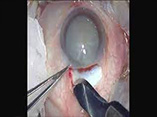Safety and Efficacy of Two Different Concentrations of Ketamine and Propofol Combinations in Cataract Surgery: A Double-blind Randomized Clinical Trial
DOI:
https://doi.org/10.31661/gmj.v11i.2744Keywords:
Sedation, Ketamine, Propofol, Ketofol, CataractAbstract
Background: Due to the importance of appropriate sedation and immobility of the patient in cataract surgery, this study was performed to compare the safety and efficacy of a combination of ketamine and propofol (ketofol) in two different ratios. Materials and Methods: This double-blind, randomized clinical trial was carried out on patients who underwent cataract surgery in Feyz Hospital, Isfahan, Iran. Patients were randomly divided into group I (n=30, ketamine/propofol 2:1 ratio) and group II (n=30, ketamine/propofol 4:1 ratio). The quality of sedation (using Ramsay sedation scale [RSS]), cardiovascular parameters such as systolic blood pressure (SBP), diastolic blood pressure (DBP), arterial blood pressure, SPO2, and heart rate, as well as patient and surgeon satisfaction, were evaluated in both groups. Results: The SPO2 and heart rate were significantly lower and higher in group I than in group II during various surgery times, respectively (P=<0.0001 for both comparisons). In terms of patient and surgeon satisfaction, it was found that no patient was dissatisfied with the sedation status in group II, while four patients (13.3%) in group I were dissatisfied (P=0.005). However, RSS, SBP, and DBP were significantly different between the two groups (P>0.05 for all comparisons). Conclusion: It seems that the use of lower ketamine doses in combination with propofol (4:1) is a safe and preferable option to provide sedation in cataract surgery.
References
Vann MA, Ogunnaike BO, Joshi GP. Sedation and anesthesia care for ophthalmologic surgery during local/regional anesthesia. Anesthesiology. 2007;107(3):502-8. https://doi.org/10.1097/01.anes.0000278996.01831.8dPMid:17721254 Lee CM, Afshari NA. The global state of cataract blindness. Curr Opin Ophthalmol. 2017;28(1):98-103. https://doi.org/10.1097/ICU.0000000000000340PMid:27820750 Mann E, Carr E. Pain management. Foundation studies for caring: using student-centred learning. Journal of Pain management. 2018;10:259. https://doi.org/10.1007/978-1-137-16202-1_15 Yağan Ö, Karakahya RH, Taş N, Küçük A. Comparison of Dexmedetomidine Versus Ketamine-Propofol Combination for Sedation in Cataract Surgery. Turk J Anaesthesiol Reanim. 2015;43(2):84-90. https://doi.org/10.5152/TJAR.2014.45220PMid:27366473 PMCid:PMC4917163 Miner JR, Moore JC, Austad EJ, Plummer D, Hubbard L, Gray RO. Randomized, double-blinded, clinical trial of propofol, 1: 1 propofol/ketamine, and 4: 1 propofol/ketamine for deep procedural sedation in the emergency department. Ann Emerg Med. 2015;65(5):479-88. https://doi.org/10.1016/j.annemergmed.2014.08.046PMid:25441247 Gokcinar D, Ergin V, Cumaoglu A, Menevse A, Aricioglu A. Effects of ketamine, propofol, and ketofol on proinflammatory cytokines and markers of oxidative stress in a rat model of endotoxemia-induced acute lung injury. Acta Biochim Pol. 2013;60(3):451-6. https://doi.org/10.18388/abp.2013_2006PMid:24020061 Nazemroaya B, Majedi MA, Shetabi H, Salmani S. Comparison of Propofol and Ketamine Combination (Ketofol) and Propofol and Fentanyl Combination (Fenofol) on Quality of Sedation and Analgesia in the Lumpectomy: A Randomized Clinical Trial. Adv Biomed Res. 2018;7:134. https://doi.org/10.4103/abr.abr_85_18PMid:30464934 PMCid:PMC6206745 Sahinovic MM, Struys MMRF, Absalom AR. Clinical Pharmacokinetics and Pharmacodynamics of Propofol. Clin Pharmacokinet. 2018;57(12):1539-58. https://doi.org/10.1007/s40262-018-0672-3PMid:30019172 PMCid:PMC6267518 Doyle DJ, Hendrix JM, Garmon EH. American Society of Anesthesiologists Classification. In: StatPearls. Treasure Island (FL): StatPearls Publishing; 2022. Griffiths RD, Jones C. Recovery from intensive care. Bmj. 1999;319(7207):427-9. https://doi.org/10.1136/bmj.319.7207.427PMid:10445926 PMCid:PMC1127042 Daabiss M, Daabiss MEM, Elsherbiny M, AlOtibi RARAR. Assessment of different concentration of Ketofol in procedural operation Assessment of different concentration of Ketofol in procedural operation. BJMP. 2009:2(1):27-31. https://doi.org/10.4103/1658-354X.51829 Yanfen WJPDFSPY, Haichun M. A randomized double-blind controlled study of the efficacy of ketofol with propofol-fentanyl and propofol alone in termination of pregnancy. African Journal of Pharmacy and Pharmacology. 2012;6(33):2488-92. https://doi.org/10.5897/AJPP12.049 Salem HA. Low-Dose Ketamine and propofol combination for upper endoscopy in morbidly obese patients. Global Journal of Anesthesiology. 2017;4(1):6-12. https://doi.org/10.17352/2455-3476.000030 Yazdi AG, Ayatollahi V, Hashemi A, Behdad S, Yazdi EG. Effect of two different concentrations of propofol and ketamine combinations (Ketofol) in pediatric patients under lumbar puncture or bone marrow aspiration. Iran J Ped Hematol Oncol. 2013;3(1):187-92. Coulter FL, Hannam JA, Anderson BJ. Ketofol simulations for dosing in pediatric anesthesia. Paediatr Anaesth. 2014;24(8):806-12. https://doi.org/10.1111/pan.12386PMid:24666723 Coulter FL, Hannam JA, Anderson BJ. Ketofol dosing simulations for procedural sedation. Pediatr Emerg Care. 2014;30(9):621-30. https://doi.org/10.1097/PEC.0000000000000222PMid:25162687 Ayatollahi V, Vafaiyan M, Hatami M, Behdad S. Two different concentrations of ketofol for procedural sedation and analgesia in closed reduction of nasal fracture. J Craniofac Surg. 2016;27(4):996-1000. https://doi.org/10.1097/SCS.0000000000002660PMid:27213735 Aydogmus MT, Türk HS, Oba S, Gokalp O. A comparison of different proportions of a ketamine-propofol mixture administered in a single injection for patients undergoing colonoscopy. Arch Med Sci. 2015;11(3):570-6. https://doi.org/10.5114/aoms.2015.52360PMid:26170850 PMCid:PMC4495153








